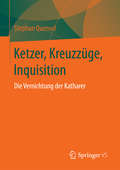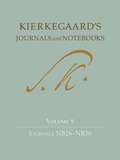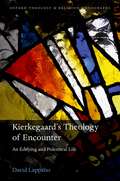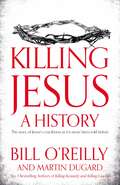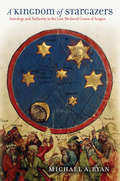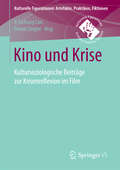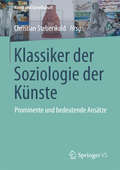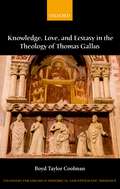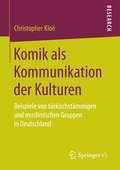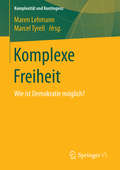- Table View
- List View
Karmic Relationships: Esoteric Studies (Karmic Relationships Ser.)
by Rudolf SteinerDuring 1924, before his last address in September, Rudolf Steiner gave over eighty lectures on the subject of karma to members of the Anthroposophical Society. These profoundly esoteric lectures examine the underlying laws inherent in reincarnation and karma, and explore in detail the incarnations of specific historical figures. In Rudolf Steiner's words, the study of karma is "... a matter of penetrating into the most profound mysteries of existence, for within the sphere of karma and the course it takes lie those processes which are the basis of the other phenomena of world existence..." In this volume, Steiner discusses the karmic relationships within the anthroposophical movement, including the predispositions which lead souls to anthroposophy, the two streams within the movement, plus Rosicrucianism, Arabism, Aristotelianism, the Platonists and the School of Michael.
Karmic Relationships: Esoteric Studies (Karmic Relationships Ser.)
by Rudolf SteinerDuring 1924, before his last address in September, Rudolf Steiner gave over eighty lectures on the subject of karma to members of the Anthroposophical Society. These profoundly esoteric commentaries examine the underlying laws of reincarnation and karma, and explore in detail the incarnations of specific historical figures. In Rudolf Steiner’s words, the study of karma is ‘... a matter of penetrating into the most profound mysteries of existence, for within the sphere of karma and the course it takes lie those processes which are the basis of the other phenomena of world existence...’ In this eighth and final volume of the series, Rudolf Steiner offers insights on a variety of subjects, including Cosmic Christianity, the Michael impulse, the Arthur and Grail streams of wisdom, as well as the individualities of Gregory VII, Haeckel, Swedenborg, Loyola, Haroun al Raschid, Byron, Voltaire and others.
Karmic Relationships: Esoteric Studies (Karmic Relationships Ser.)
by Rudolf SteinerThese profoundly esoteric lectures examine the underlying laws inherent in reincarnation and karma. In Steiner's words, the study of karma is "... a matter of penetrating into the most profound mysteries of existence, for within the sphere of karma and the course it takes lie processes which are the basis of the other phenomena of world existence..." This volume focuses on human experiences after death and before a new birth; karma in world history; the cosmic nature of Christ; waking, dreaming, sleeping; and the physical effects of karma.
Karmic Relationships: Esoteric Studies (Karmic Relationships Ser.)
by Rudolf SteinerThese lectures examine the underlying laws inherent in reincarnation and karma. This volume focuses on the karmic groups of souls connected to Aristotelianism and Platonism, the karma of the anthroposophical movement, as well as the individual incarnations of Ernst Haeckel, Vladimir Solovioff and others. This new edition also includes Steiner's last address.
Ketzer, Kreuzzüge, Inquisition: Die Vernichtung der Katharer
by Stephan QuenselDer erste Band einer ‚Geschichte professioneller Kontrolle’ untersucht, wie es im Mittelalter, einer Zeit, in der er noch keinen Staat per se gab, gelang, die vom orthodoxen Glauben abweichenden Ketzer systematisch auszurotten, um damit ein Leitbild für alle künftigen Kontroll-Institutionen – von der frühneuzeitlichen Hexenverfolgung über die Geschichte der Psychiatrie bis hin zur gegenwärtigen Drogenpolitik – zu schaffen. Am Beispiel der Inquisition der Katharer im französischen Languedoc während des 12. und 13. Jahrhunderts wird deren machtpolitischer, religiös-mentaler und kultureller Hintergrund beschrieben. Dabei gewinnt der 200-jährige Kontakt mit einer fortgeschritteneren und toleranteren islamischen Kultur während der spanischen Reconquista und der Kreuzzüge ins Heilige Land eine besondere aktuelle Bedeutung.
The Keys and the Kingdom: The British and the Papacy from John Paul II to Francis
by Catherine PepinsterCatherine Pepinster charts the relationship between the British and the papacy in the modern era, looking at how this relationship is coloured by its turbulent past. Despite the enmity of previous centuries, Pepinster uncovers surprising instances of influence of the papacy in British politics, the collaboration between Pope and politicians on key issues, the 'stealth minority' of Catholics occupying major positions in public life, and the modern relationship between the Papacy and the Crown. In addition Pepinster analyses the crucial role that Britain has played in Rome, uncovers the unexpected role of the British Foreign Office in the appointment of Pope Francis, and discusses the modern style of the papacy and how this functions on a global scale. Featuring exclusive interviews with Cardinals Nichols and Murphy-O'Connor, Rowan Williams, Lord Patten and former British Ambassadors to both the Holy See and Italy, this account of the contemporary relationship between Great Britain and the Pope offers both fundamental evidence and penetrating insights into this most fascinating of political relationships.
The Keys and the Kingdom: The British and the Papacy from John Paul II to Francis
by Catherine PepinsterCatherine Pepinster charts the relationship between the British and the papacy in the modern era, looking at how this relationship is coloured by its turbulent past. Despite the enmity of previous centuries, Pepinster uncovers surprising instances of influence of the papacy in British politics, the collaboration between Pope and politicians on key issues, the 'stealth minority' of Catholics occupying major positions in public life, and the modern relationship between the Papacy and the Crown. In addition Pepinster analyses the crucial role that Britain has played in Rome, uncovers the unexpected role of the British Foreign Office in the appointment of Pope Francis, and discusses the modern style of the papacy and how this functions on a global scale. Featuring exclusive interviews with Cardinals Nichols and Murphy-O'Connor, Rowan Williams, Lord Patten and former British Ambassadors to both the Holy See and Italy, this account of the contemporary relationship between Great Britain and the Pope offers both fundamental evidence and penetrating insights into this most fascinating of political relationships.
Kierkegaard's Concept of Despair
by Michael Theunissen Barbara Harshav Helmut IllbruckThe literature on Kierkegaard is often content to paraphrase. By contrast, Michael Theunissen articulates one of Kierkegaard's central ideas, his theory of despair, in a detailed and comprehensible manner and confronts it with alternatives. Understanding what Kierkegaard wrote on despair is vital not only because it illuminates his thought as a whole, but because his account of despair in The Sickness unto Death is the cornerstone of existentialism. Theunissen's book, published in German in 1993, is widely regarded as the best treatment of the subject in any language. Kierkegaard's Concept of Despair is also one of the few works on Kierkegaard that bridge the gap between the Continental and analytic traditions in philosophy. Theunissen argues that for Kierkegaard, the fundamental characteristic of despair is the desire of the self "not to be what it is." He sorts through the apparently chaotic text of The Sickness unto Death to explain what Kierkegaard meant by the "self," how and why individuals want to flee their selves, and how he believed they could reconnect with their selves. According to Theunissen, Kierkegaard thought that individuals in despair seek to deny their authentic selves to flee particular aspects of their character, their past, or the world, or in order to deny their "mission." In addition to articulating and evaluating Kierkegaard's concept of despair, Theunissen relates Kierkegaard's ideas to those of Heidegger, Sartre, and other twentieth-century philosophers.
Kierkegaard's Journals and Notebooks, Volume 9: Journals NB26–NB30
by Søren Kierkegaard Niels Jørgen Cappelørn Alastair Hannay Bruce H. Kirmmse David D. Possen Joel D.S. Rasmussen Vanessa Rumble Research CentreFor over a century, the Danish thinker Søren Kierkegaard (1813–55) has been at the center of a number of important discussions, concerning not only philosophy and theology, but also, more recently, fields such as social thought, psychology, and contemporary aesthetics, especially literary theory.Despite his relatively short life, Kierkegaard was an extraordinarily prolific writer, as attested to by the 26-volume Princeton University Press edition of all of his published writings. But Kierkegaard left behind nearly as much unpublished writing, most of which consists of what are called his "journals and notebooks." Kierkegaard has long been recognized as one of history's great journal keepers, but only rather small portions of his journals and notebooks are what we usually understand by the term “diaries.” By far the greater part of Kierkegaard’s journals and notebooks consists of reflections on a myriad of subjects—philosophical, religious, political, personal. Studying his journals and notebooks takes us into his workshop, where we can see his entire universe of thought. We can witness the genesis of his published works, to be sure—but we can also see whole galaxies of concepts, new insights, and fragments, large and small, of partially (or almost entirely) completed but unpublished works. Kierkegaard’s Journals and Notebooks enables us to see the thinker in dialogue with his times and with himself.Kierkegaard wrote his journals in a two-column format, one for his initial entries and the second for the extensive marginal comments that he added later. This edition of the journals reproduces this format, includes several photographs of original manuscript pages, and contains extensive scholarly commentary on the various entries and on the history of the manuscripts being reproduced.Volume 9 of this 11-volume series includes five of Kierkegaard’s important “NB” journals (Journals NB26 through NB30), which span from June 1852 to August 1854. This period was marked by Kierkegaard’s increasing preoccupation with what he saw as an unbridgeable gulf in Christianity—between the absolute ideal of the religion of the New Testament and the official, state-sanctioned culture of “Christendom,” which, embodied by the Danish People’s Church, Kierkegaard rejected with increasing vehemence. Crucially, Kierkegaard’s nemesis, Bishop Jakob Peter Mynster, died during this period and, in the months following, Kierkegaard can be seen moving inexorably toward the famous “attack on Christendom” with which he ended his life.
Kierkegaard's Theology of Encounter: An Edifying and Polemical Life (Oxford Theology and Religion Monographs)
by David LappanoKierkegaard's Theology of Encounter provides a theoretical framework that brings the unity of Kierkegaard's 'middle period' into relief. David Lappano analyses Kierkegaard's writings between 1846 and 1852 when the socially constructive dimension of his thought comes to prominence, involving two dialectical aspects of religiousness identified by Kierkegaard: they are the edifying and the polemical. How these come together and get worked out in the lives of individuals form the basis of what can be called a Kierkegaardian 'social praxis'. Lappano argues that the tension between the edifying and the polemical can be coherently maintained in a communicative life that is also characteristic of a militant faith. This militant faith and life is presented as a critical guard against absolutisms, fundamentalisms, and intellectual aloofness; but the 'militant' individual is also utterly dependent, in need of edification and critique, and therefore chooses the risk of encountering others, seeking relationships out of a commitment to the development of people and communities in co-operation. Therefore, not only does this dialectic provide readers with an important theoretical framework for understanding Kierkegaard's 'middle period', it is also a valuable resource for a constructive analysis of active social living suitable for theology in the twenty-first century.
Killing Jesus: A History (Bill O'reilly's Killing Ser.)
by Bill O'Reilly Martin DugardThe story of Jesus’s crucifixion as it’s never been told before Millions of readers have been thrilled by author Bill O’Reilly and historian Martin Dugard’s Killing Kennedy and Killing Lincoln, page-turning works of non-fiction that have changed the way we read history. Now the anchor of The O’Reilly Factor details the shocking events leading up to the execution of the most influential man who ever lived: Jesus of Nazareth. Nearly two thousand years after this beloved and controversial young revolutionary was brutally killed by Roman soldiers, more than 2.2 billion people attempt to follow his teachings and believe he is God. In this riveting and fact-based account of Jesus’s life and times, Julius Caesar, Cleopatra, Caesar Augustus, Herod the Great, Pontius Pilate, and John the Baptist are among the many legendary figures who rise up off the page. Killing Jesus not only takes readers inside this most volatile epoch, it also recounts the seismic political and historical events that made Jesus’s death inevitable – and changed the world for ever.
The King Never Smiles: A Biography Of Thailand's Bhumibol Adulyadej (PDF)
by Paul M. HandleyThailand's Bhumibol Adulyadej, the only king ever born in the United States, came to the throne of his country in 1946 and at the time of his death, in October 2016, was the world's longest serving monarch. Now out in paperback with a new preface by author Paul Handley, The King Never Smiles is the first independent biography of Thailand's monarch, tells the unexpected story of Bhumibol's life and seventy year rule-how a Western raised boy came to be seen by his people as a living Buddha, and how a king widely seen as beneficent and apolitical could in fact be so deeply political and autocratic. Paul Handley provides an extensively researched, factual account of the king's youth and personal development, ascent to the throne, skillful political maneuverings, and attempt to shape Thailand as a Buddhist kingdom. Handley takes full note of Bhumibol's achievements in art, in sports, and in jazz, and he credits the king's lifelong dedication to rural development and the livelihoods of his poorest subjects. But, looking beyond the widely accepted image of the king as egalitarian and virtuous, Handley portrays an anti democratic monarch who, together with allies in big business and the corrupt Thai military, protected a centuries old, barely modified feudal dynasty. When at nineteen Bhumibol assumed the throne, the Thai monarchy had been stripped of power and prestige. Over the ensuing decades, Bhumibol became the paramount political actor in the kingdom, silencing critics while winning the hearts and minds of his people. The book details this process and depicts Thailand's unique constitutional monarch-his life, his thinking, and his ruling philosophy.
The Kingdom
by Emmanuel Carrère John Lambert'The Kingdom, already a huge bestseller in France, is thrilling, magnificent and strange' Bryan Appleyard, Sunday Times'An utterly brilliant book' Catherine Nixey, The TimesThe sensational international bestseller from one of France's most fêted writers - an epic novel telling the story of Christianity as it has never been told before, and one man's crisis of faith.Corinth, ancient Greece, two thousand years ago. An itinerant preacher, poor, wracked by illness, tells the story of a prophet who was crucified in Judea, who came back from the dead, and whose return is a sign of something enormous. Like a contagion, the story will spread over the city, the country and, eventually, the world. Emmanuel Carrère's astonishing historical epic tells the story of the mysterious beginnings of Christianity, bringing to life a distant, primeval past of strange sects, apocalyptic beliefs and political turmoil. In doing so Carrère, once himself a fervent believer, questions his own faith, asks why we believe in resurrection, and what it means. The Kingdom is his masterpiece.
A Kingdom of Stargazers: Astrology and Authority in the Late Medieval Crown of Aragon
by Michael A. RyanAstrology in the Middle Ages was considered a branch of the magical arts, one informed by Jewish and Muslim scientific knowledge in Muslim Spain. As such it was deeply troubling to some Church authorities. Using the stars and planets to divine the future ran counter to the orthodox Christian notion that human beings have free will, and some clerical authorities argued that it almost certainly entailed the summoning of spiritual forces considered diabolical. We know that occult beliefs and practices became widespread in the later Middle Ages, but there is much about the phenomenon that we do not understand. For instance, how deeply did occult beliefs penetrate courtly culture and what exactly did those in positions of power hope to gain by interacting with the occult? In A Kingdom of Stargazers, Michael A. Ryan examines the interest in astrology in the Iberian kingdom of Aragon, where ideas about magic and the occult were deeply intertwined with notions of power, authority, and providence. Ryan focuses on the reigns of Pere III (1336–1387) and his sons Joan I (1387–1395) and Martí I (1395–1410). Pere and Joan spent lavish amounts of money on astrological writings, and astrologers held great sway within their courts. When Martí I took the throne, however, he was determined to purge Joan’s courtiers and return to religious orthodoxy. As Ryan shows, the appeal of astrology to those in power was clear: predicting the future through divination was a valuable tool for addressing the extraordinary problems—political, religious, demographic—plaguing Europe in the fourteenth century. Meanwhile, the kings' contemporaries within the noble, ecclesiastical, and mercantile elite had their own reasons for wanting to know what the future held, but their engagement with the occult was directly related to the amount of power and authority the monarch exhibited and applied. A Kingdom of Stargazers joins a growing body of scholarship that explores the mixing of religious and magical ideas in the late Middle Ages.
Kino und Krise: Kultursoziologische Beiträge zur Krisenreflexion im Film (Kulturelle Figurationen: Artefakte, Praktiken, Fiktionen)
by Il-Tschung Lim Daniel ZieglerDie Beiträge des vorliegenden Bandes fragen nach den sozial- und kulturwissenschaftlichen Perspektiven einer gesellschaftlichen Reflexion von Krisen und krisenhaften Ereignissen im Medium des fiktionalen Films. Ihnen gemeinsam ist die Annahme, dass Krisen nicht einfach in einer unzweideutig vorliegenden phänomenalen Realität gegeben sind, sie jedoch auch nicht lediglich diskursive Konstruktionen ohne eine eigene Materialität darstellen. Krisen werfen nicht nur Probleme ihrer operativen Bearbeitung auf, sondern konfrontieren Gesellschaften auch mit einem Beobachtungs- und Darstellungsproblem. Was wird wann und vom wem als eine Krise bezeichnet? Welche Vorstellungen, Konzepte, Begriffe, Narrative oder Bilder von Krisen zirkulieren in der Gesellschaft? Wie wird die Krise als ein Wissensobjekt konstituiert? Mit diesen Fragen rücken die spezifischen Verfahren und Prozeduren in der Bezeichnung und Repräsentation von gesellschaftlichen Krisen in den Mittelpunkt der Analyse – und damit jene Repräsentationsmedien, in denen sich die Krisenreflexion ausdrückt. In der Explikation des ästhetisch-epistemologischen Potenzials filmischer Fiktionen liegt dann, so die Grundannahme des vorliegenden Bandes, die Chance auf den spezifischen Mehrwert für eine kultursoziologisch orientierte Filmsoziologie.
Klassiker der Soziologie der Künste: Prominente und bedeutende Ansätze (Kunst und Gesellschaft)
by Christian SteuerwaldDie Soziologie kennt zahlreiche Schriften, die Einführungen in die Geschichte der Soziologie, Zusammenfassungen über spezielle Forschungsgebiete und -fragen oder Überblicke über die ›Klassiker‹ des Fachs bieten. Auch wenn in jüngster Zeit verschiedene kunstsoziologische Einführungen und Überblicksbände veröffentlicht worden sind, fehlt in der Soziologie der Künste eine aktuelle Zusammenstellung der ›Klassiker‹. In Folge der intensiven Auseinandersetzungen um den Klassikerbegriff in der Soziologie sowie umfangreicher Weiterentwicklungen der Soziologie der Künste kann es in einer aktuellen Zusammenstellung aber nicht nur um ›Klassiker‹ an sich gehen. Gerade die Soziologie der Künste weist verschiedene höchst bedeutende und prominente Ansätze auf, die nur auf höchst problematische Weise mit dem Klassikerbegriff in welcher Form auch immer zu vereinbaren sind. Dementsprechend geht es in dem Buch nicht nur um ›Klassiker‹. Vielmehr sollen auch Kultur- und Sozialwissenschaftlerinnen beziehungsweise Kultur- und Sozialwissenschaftler aufgenommen werden, die richtungsweisende Arbeiten für eine Soziologie der Kunst vorgelegt haben.
Knowledge, Love, and Ecstasy in the Theology of Thomas Gallus (Changing Paradigms in Historical and Systematic Theology)
by Boyd Taylor CoolmanKnowledge, Love, and Ecstasy in the Theology of Thomas Gallus provides the first full study of Thomas Gallus (d. 1246) in English and represents a significant advance in his distinctive theology. Boyd Taylor Coolman argues that Gallus distinguishes, but never separates and intimately relates two international modalities in human consciousness: the intellective and the affective, both of which are forms of cognition. Coolman shows that Gallus conceives these two cognitive modalities as co-existing in an interdependent manner, and that this reciprocity is given a particular character by Gallus anthropological appropriation of the Dionysian concept of hierarchy. Because Gallus conceives of the soul as hierarchized on the model of the angelic hierarchy, the intellect-affect relationship is fundamentally governed by the dynamism of a Dionysian hierarchy, which has two simultaneous trajectories: ascending and descending. Two crucial features are noteworthy in this regard: in ascending, firstly, the lower is subsumed by the higher; in descending, secondly, the higher communicates with the lower, according to the nature of the lower. When Gallus posits a higher, affective cognitio above an intellective cognitio at the highest point in the ascent, accordingly, this higher affective form both builds upon and sublimates the lower intellective form. At the same time, this affective cognitio descends back down into the soul, both enriching its properly intellective capacity and also renewing the ascending movement in love. For Gallus, then, in the hierarchized soul a dynamic mutuality between intellect and affect emerges, which he construes as a spiralling motion, by which the soul unceasingly stretches beyond itself, ecstatically, in knowing and loving God.
Komik als Kommunikation der Kulturen: Beispiele von türkischstämmigen und muslimischen Gruppen in Deutschland
by Christopher KloëChristopher Kloë stellt in diesem Buch Samuel Huntingtons Hypothese eines Kampfes der Kulturen die Systematik einer Begegnung der Kulturen gegenüber. Diese wird durch das Mittel der medialen komischen Kommunikation von (Selbst-)Darstellungen anhand der Thesen von Homi K. Bhabha, Thilo Sarrazin, Alfred Schütz und Zygmunt Bauman erläutert. Der Vorgang einer ansteigenden Auseinandersetzung mit den jeweils Fremden auch in der Form von komischen Inszenierungen, die als analog zum ansteigenden Eintritt von Fremden in den lokalen sozialen Raum betrachtet wird, erläutert der Autor am Beispiel von türkischstämmigen und muslimischen Gruppen in Deutschland und im Vergleich zu Minderheiten im westlichen Kulturkreis.
Komplexe Freiheit: Wie ist Demokratie möglich? (Komplexität und Kontingenz)
by Maren Lehmann Marcel TyrellDie ZU|Schriften bewegen sich im Rahmen der Unterscheidung von Komplexität und Kontingenz, um die Überlegung diskutieren zu können, dass jede soziale Umgebung ein vernetzter, komplexer Zusammenhang ist, der sich in ein verstehbares und bearbeitbares, orientierendes Format bringen und dabei die kontingente Selektivität dieses Formats mitreflektieren, sich also organisieren muss, um handlungsfähig zu sein und kritikfähig zu bleiben. Der vorliegende Band nimmt diese Überlegung als Frage nach der Möglichkeit ernst, Freiheit und Demokratie zu verbinden. Ist Demokratie eine Form komplexer Freiheit, das heißt vor allem: wird Freiheit durch Demokratie ermöglicht?Begriffsfragen bestimmen zunächst das Problem einer Freiheit genauer, die komplex ist, weil sie eingeschränkt ist, ohne festgelegt zu sein. Den Herausforderungen, die sich aus dieser spezifisch modernen Freiheitsform ergeben, gehen Verständigungsfragen und Machtfragen nach; sie suchen nach den Formen der Freiheit in demokratisch verfassten Ordnungen und sehen sich auch die politischen Risiken an, die durch ein Wechselspiel von Vereinfachung und Verkomplizierung in massenmedialen Öffentlichkeiten, rechtlichen Verfahren und hierarchischen Organisationen entstehen können. Kann die Komplexität der sozialen Welt so sehr anwachsen, dass Ordnungsbedürfnisse unbefriedigt bleiben? Kann die Kontingenz der sozialen Ordnung zu derart überfordernden Ungewissheiten und Unsicherheiten führen, dass nostalgische Blindheiten wie Zukunftsversprechen begrüßt werden?
Konfessionelle Wohlfahrtsverbände im Umbruch: Fortführung des deutschen Sonderwegs durch vorsorgende Sozialpolitik? (Studien der Bonner Akademie für Forschung und Lehre praktischer Politik)
by Wolfgang SchroederCaritas und Diakonie zählen zu den zentralen Akteuren im deutschen Sozialstaat. Sie stellen einen großen Anteil der sozialstaatlichen Leistungen bereit und haben diese im Laufe der Zeit stetig ausgeweitet und ausdifferenziert. In neuerer Zeit müssen sie sich im Strukturwandel des Wohlfahrtskorporatismus neu positionieren. In diesem Band wird danach gefragt, inwiefern sie sich einer betriebswirtschaftlichen Steuerung unterworfen haben und ihre Identität sowie ihre Verbindung zur Kirche bewahren konnten. Zugleich wird analysiert, wie sie die Potentiale vorsorgender Sozialpolitik erkannt haben, um sich für die Modernisierung des Sozialstaats aufzustellen.Die Analyse der Organisation, der Programmatik und der operativen Tätigkeit der konfessionellen Wohlfahrtsverbände in diesem Transformationsprozess wird um Interviews mit langjährigen Beobachtern der Verbände aus Wissenschaft und Praxis ergänzt.
The Koran in English: A Biography
by Bruce B. LawrenceThe untold story of how the Arabic Qur'an became the English KoranFor millions of Muslims, the Qur'an is sacred only in Arabic, the original Arabic in which it was revealed to the Prophet Muhammad in the seventh century; to many Arab and non-Arab believers alike, the book literally defies translation. Yet English translations exist and are growing, in both number and importance. Bruce Lawrence tells the remarkable story of the ongoing struggle to render the Qur'an's lyrical verses into English—and to make English itself an Islamic language.The "Koran" in English revisits the life of Muhammad and the origins of the Qur'an before recounting the first translation of the book into Latin by a non-Muslim: Robert of Ketton's twelfth-century version paved the way for later ones in German and French, but it was not until the eighteenth century that George Sale's influential English version appeared. Lawrence explains how many of these early translations, while part of a Christian agenda to "know the enemy," often revealed grudging respect for their Abrahamic rival. British expansion in the modern era produced an anomaly: fresh English translations—from the original Arabic—not by Arabs or non-Muslims but by South Asian Muslim scholars.The first book to explore the complexities of this translation saga, The "Koran" in English also looks at cyber Korans, versions by feminist translators, and now a graphic Koran, the American Qur'an created by the acclaimed visual artist Sandow Birk.
The Koran in English: A Biography
by Bruce B. LawrenceThe untold story of how the Arabic Qur'an became the English KoranFor millions of Muslims, the Qur'an is sacred only in Arabic, the original Arabic in which it was revealed to the Prophet Muhammad in the seventh century; to many Arab and non-Arab believers alike, the book literally defies translation. Yet English translations exist and are growing, in both number and importance. Bruce Lawrence tells the remarkable story of the ongoing struggle to render the Qur'an's lyrical verses into English—and to make English itself an Islamic language.The "Koran" in English revisits the life of Muhammad and the origins of the Qur'an before recounting the first translation of the book into Latin by a non-Muslim: Robert of Ketton's twelfth-century version paved the way for later ones in German and French, but it was not until the eighteenth century that George Sale's influential English version appeared. Lawrence explains how many of these early translations, while part of a Christian agenda to "know the enemy," often revealed grudging respect for their Abrahamic rival. British expansion in the modern era produced an anomaly: fresh English translations—from the original Arabic—not by Arabs or non-Muslims but by South Asian Muslim scholars.The first book to explore the complexities of this translation saga, The "Koran" in English also looks at cyber Korans, versions by feminist translators, and now a graphic Koran, the American Qur'an created by the acclaimed visual artist Sandow Birk.
The Koran in English: A Biography (Lives of Great Religious Books #27)
by Bruce B. LawrenceThe untold story of how the Arabic Qur'an became the English KoranFor millions of Muslims, the Qur'an is sacred only in Arabic, the original Arabic in which it was revealed to the Prophet Muhammad in the seventh century; to many Arab and non-Arab believers alike, the book literally defies translation. Yet English translations exist and are growing, in both number and importance. Bruce Lawrence tells the remarkable story of the ongoing struggle to render the Qur'an's lyrical verses into English—and to make English itself an Islamic language.The "Koran" in English revisits the life of Muhammad and the origins of the Qur'an before recounting the first translation of the book into Latin by a non-Muslim: Robert of Ketton's twelfth-century version paved the way for later ones in German and French, but it was not until the eighteenth century that George Sale's influential English version appeared. Lawrence explains how many of these early translations, while part of a Christian agenda to "know the enemy," often revealed grudging respect for their Abrahamic rival. British expansion in the modern era produced an anomaly: fresh English translations—from the original Arabic—not by Arabs or non-Muslims but by South Asian Muslim scholars.The first book to explore the complexities of this translation saga, The "Koran" in English also looks at cyber Korans, versions by feminist translators, and now a graphic Koran, the American Qur'an created by the acclaimed visual artist Sandow Birk.
The Koran in English: A Biography (Lives of Great Religious Books #27)
by Bruce B. LawrenceThe untold story of how the Arabic Qur'an became the English KoranFor millions of Muslims, the Qur'an is sacred only in Arabic, the original Arabic in which it was revealed to the Prophet Muhammad in the seventh century; to many Arab and non-Arab believers alike, the book literally defies translation. Yet English translations exist and are growing, in both number and importance. Bruce Lawrence tells the remarkable story of the ongoing struggle to render the Qur'an's lyrical verses into English—and to make English itself an Islamic language.The "Koran" in English revisits the life of Muhammad and the origins of the Qur'an before recounting the first translation of the book into Latin by a non-Muslim: Robert of Ketton's twelfth-century version paved the way for later ones in German and French, but it was not until the eighteenth century that George Sale's influential English version appeared. Lawrence explains how many of these early translations, while part of a Christian agenda to "know the enemy," often revealed grudging respect for their Abrahamic rival. British expansion in the modern era produced an anomaly: fresh English translations—from the original Arabic—not by Arabs or non-Muslims but by South Asian Muslim scholars.The first book to explore the complexities of this translation saga, The "Koran" in English also looks at cyber Korans, versions by feminist translators, and now a graphic Koran, the American Qur'an created by the acclaimed visual artist Sandow Birk.
Koranexegese als »Mix and Match«: Zur Diversität aktueller Diskurse in der tafsir-Wissenschaft (Globaler lokaler Islam)
by Abbas PoyaDie Beschäftigung mit dem Koran ist nicht nur ein zentrales Interesse muslimischer Gelehrsamkeit, sie ist auch wichtig, um die geistig-religiösen Hintergründe der verschiedenen - fundamentalistischen, liberalen, traditionellen oder modernen - Positionen im Islam zu verstehen. Dieser Band diskutiert texthermeneutische Zugänge aus verschiedenen Regionen des Islam - von der Türkei über Ägypten, Syrien, den Iran bis hin zu Indien. Die Beiträge konturieren die Koranexegese als eine Mix-and-Match-Hermeneutik, an der verschiedene Akteure mit unterschiedlichen Erkenntnisinteressen, methodischen Ansätzen und Lebenserfahrungen beteiligt sind. Auf diese Weise wird die Pluralität im islamischen Denken und Handeln als selbstverständlich erachtet und u.a. in den unterschiedlichen Zugängen zum Koran begründet.




